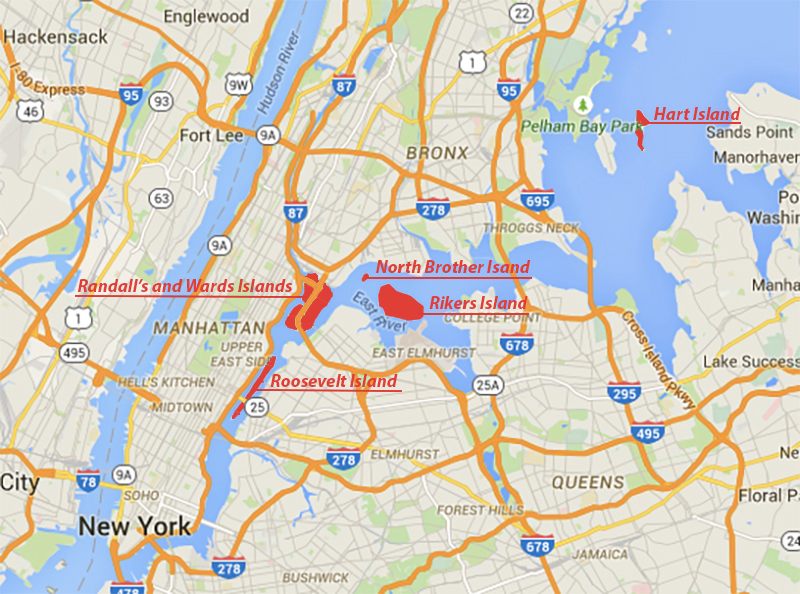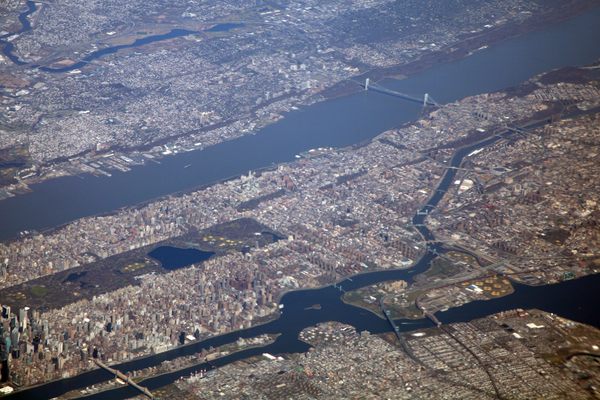Islands of the Undesirables: Hart Island

An aerial view of Hart Island (lower right), next to City Island (Photo: Doc Searls/Flickr)
This is the fourth installment of five-part series on New York City’s tendency to put its undesirables on islands around the boroughs, based on this past weekend’s Obscura Day event. Monday was Roosevelt Island, Tuesday was Randall’s Island and Wards Island, Wednesday was North Brother Island and today we look at Hart Island.

A map of the islands that are featured in Atlas Obscura’s Islands of the Undesirables series (Photo: Map Data © 2015 Google)
In a dense, expensive city, the poor aren’t the least desirable citizens—the poor and dead are. In New York City, these undesirables end up on Hart Island.
In its earliest days, New York buried its poorest inhabitants in a potters field at the southern tip of Manhattan, near Chambers Street. As the city moved north, so did the potters’ field, to the current sites of Washington Square, Bellevue Hospital, Madison Square, Bryant Park, and the Waldorf-Astoria, among other locations.
In the 1840s, the field was moved off Manhattan entirely, to Randall’s and Wards Islands, and in 1869, the city’s tenth—and so far, its last—potters field opened on the northern end of Hart Island.
Today, Hart Island is the largest tax-funded cemetery in the world, with close to a million graves arranged in a vast complex of trenches. If you die in New York City and no one claims your body within a week, this is where you end up. It’s not just for John and Jane Does, but anyone whose family is too poor—or is otherwise unable—to claim them. If you do have a loved one buried on its shores, Hart’s Island is also notable for its bureaucratic cruelty. The island is run by the federal Department of Corrections like a prison for the dead and mourners are permitted only as far as a small gazebo. No photographs allowed.
 Abandoned buildings on Hart Island (Photo: Adam Moss/Flickr)
Abandoned buildings on Hart Island (Photo: Adam Moss/Flickr)
Unlike many other local islands, Hart wasn’t named for a person. The name may come from a British cartographer who thought the island was shaped like a heart, or who named it after the Middle English word for deer. Besides a burial ground, the island has also been the site of early 19th century bare-knuckled boxing matches (often subject to raids when held in Manhattan), a Civil War training ground, World War II disciplinary barracks and (briefly) a Nike missile base. During the 19th century, there was also an industrial school for vagrant boys, an almshouse, a lunatic asylum, a jail workhouse, and a youth reformatory, among other institutions.
Despite its dismal past and present, there have been some less-expected interludes in the island’s history: in the 1920s, a developer named Solomon Riley began building an amusement park for Harlem blacks excluded from the “whites-only” facilities elsewhere. Builders had already constructed 200 feet of boardwalk, a dance hall, and other structures when the city halted the project (planned for right near the jail), fearing prisoner escapes and an influx of contraband. In the 1960s and early 1970s, a drug rehab program called Phoenix House was also located on the island, and sponsored annual sober art-and-music festivals—the Velvet Underground headlined one of them.

Buildings on Hart Island (Photo: Adam Moss/Flickr)
But today, the island is used only as a burial ground. It is owned by the Department of Corrections, and Rikers Island inmates perform the burials, earning fifty cents an hour. Bodies are placed in plain wooden coffins, within common graves that stretch for 70 feet. Most of the graves are unmarked, although there is one exception—the first baby to die of AIDS in New York has a tombstone. Access is tightly controlled by the Department of Corrections, which for years has allowed only sporadic “closure visits” where relatives can only get as far as a gazebo near the docks.
Over the past few decades, an artist named Melinda Hunt has been pushing to get more transparency around Hart Island from the city, whose record-keeping has often been abysmal. Hunt’s Hart Island Project has used Freedom of Information requests to obtain and digitize burial records, and her online Travelling Cloud Museum collects the stories of those who have ended up the island. “Clocks of anonymity,” one for each burial since 1980, tick away on the website, and are stopped only when someone adds a story in memory of the deceased.
Hunt notes that New York is the only city in America, perhaps the world, to bury its unclaimed dead with prison labor, and argues that the practice is a Dickensian holdover from the time when the island was home to both a potters field and a jail. But the island’s fortunes may change, and soon. The ACLU filed a class action suit in December to open up the grounds to mourners and a bill currently before New York City Council would transfer jurisdiction over the island from the Department of Correction to the Department of Parks and Recreation, while a separate bill would establish regular public ferry service to the island. If the bills pass—a big but not impossible “if”—Hart could join Roosevelt, Randall’s and other New York islands as a place that’s been transformed from one of the “islands of the undesirables” to being a thriving addition to the mainstream of New York City life.

(Photo: Adam Moss/Flickr)







Follow us on Twitter to get the latest on the world's hidden wonders.
Like us on Facebook to get the latest on the world's hidden wonders.
Follow us on Twitter Like us on Facebook